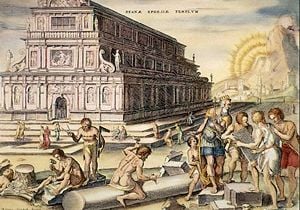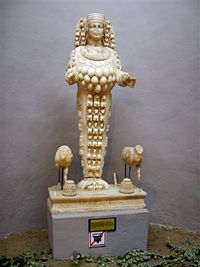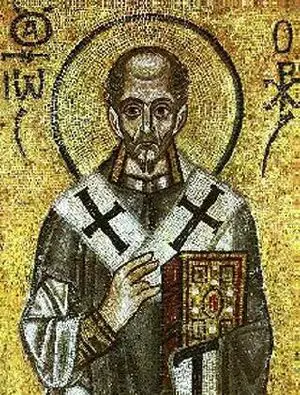Temple of Artemis
The Temple of Artemis was a magnificent place of worship in the city of Ephesus in present-day Turkey, dedicated to Artemis, the Greek goddess of the hunt. Although earlier destroyed and rebuilt, it was completed, in its most famous phase, around 550 B.C.E. under the Achaemenid dynasty of the Persian Empire. It was rebuilt again several centuries later and endured into the end of the fourth century C.E. It is considered one of the Seven Wonders of the Ancient World.
The temple was described by Philo of Byzantium:
I have seen the walls and Hanging Gardens of ancient Babylon, the statue of Olympian Zeus, the Colossus of Rhodes, the mighty work of the high Pyramids and the tomb of Mausolus. But when I saw the temple at Ephesus rising to the clouds, all these other wonders were put in the shade.
The temple became a worship center for people of all faiths from many lands, including a sect of Ephesians who worshiped Cybele, the Greek Earth Mother goddess. It was also known as the Temple of Diana, the equivalent Roman goddess to Artemis. The temple was said to be a fantastic structure made of marble, with gold and silver decoration and the finest art and statuary of the age. It was burned down on July 21, 356 B.C.E. by agents of a man called Herostratus, who reportedly sought worldwide fame by destroying the world's most beautiful building. It was later rebuilt several times. Its ultimate destruction occurred at the hands of a Christian mob led by St. John Chrysostom, then archbishop of Ephesus, in 401 C.E.
Origins

Test holes have confirmed the temple site was occupied as early as the Bronze Age. Included in the find were layers of pottery that extended forward to later times, when the clay-floored, classical temple, surrounded by a single row of columns, was constructed in the second half of the eighth century B.C.E. The temple at Ephesus was the earliest known example of a colonnaded temple on the coast of Asia Minor, and perhaps the earliest Greek temple anywhere surrounded by colonnades.
In the seventh century, a flood destroyed the temple, depositing over 1.6 feet of sand and scattering flotsam over the former floor of hard-packed clay. In the flood debris were the remains of a carved, ivory plaque of a griffin, the fabled monster with the head and wings of an eagle and the body of a lion, and the Tree of Life, apparently North Syrian. More importantly, flood deposits, buried in place a precious find against the north wall that included drilled amber, tear-shaped drops with elliptical cross-sections, which had once dressed the wooden image of the Lady of Ephesus. Bammer (1990) notes that the flood-prone site was raised about six and one-half feet between the eight and sixth centuries B.C.E., and almost eight feet between the sixth and the fourth centuries B.C.E. This indicates that the site itself must have had sacred meaning, since it would have been easier to move the temple.
The Great Temple
The new and most famous temple was constructed around 550 B.C.E. by the Cretan architect Chersiphron and his son Metagenes. It was built of marble, with its colonnades doubled to make a wide ceremonial passage around the central structure of the classical temple. A new ebony or grape wood statue of Artemis was created and a small, classical temple to house it was erected east of the open-air altar.
This enriched reconstruction was sponsored by Croesus, the wealthy king of Lydia. More than a thousand items have been recovered from the temple, including what may be the earliest coins of the silver-gold alloy, electrum. The temple became a tourist attraction, visited by merchants, kings, and sightseers, many of whom paid homage to Artemis in the form of jewelry and various goods. It was also a widely respected place of refuge, a tradition that was linked in myth with the Amazons who reportedly took refuge there, both from Heracles and from Dionysus.
Initial destruction
The temple was destroyed on July 21, 356 B.C.E. in an act of arson. The crime was initiated by a man named Herostratus, whose motivation was fame at any cost: "A man was found to plan the burning of the temple of Ephesian Diana so that through the destruction of this most beautiful building his name might be spread through the whole world."[1]
The citizens of Ephesus, outraged at the act, intended that Herostratus' name never be recorded. The historian Strabo, however, later noted the name, which is how it is known today.
Rebuilding efforts
On the very same night the temple was destroyed, Alexander the Great was born. Plutarch remarked that Artemis was too preoccupied with Alexander's delivery to save her burning temple. Alexander later offered to pay for the temple's rebuilding, but the Ephesians refused. Eventually, the temple was restored after Alexander's death, in 323 B.C.E.
This reconstruction was itself destroyed during a raid by the Goths in 262, in the time of Emperor Gallienus: "Respa, Veduc and Thuruar, leaders of the Goths, took ship and sailed across the strait of the Hellespont to Asia. There they laid waste many populous cities and set fire to the renowned temple of Diana at Ephesus," reported the historian Jordanes (Getica 20:107). The temple was again rebuilt, however, and continued to be known as one of the wonders of the world until well into the Christian era.
Christianity and the temple
The temple figures in several Christian stories, and it would be a famous Christian archbishop that ultimately destroyed it.
In the Bible, Acts 19 speaks of an Ephesian mob attacking Saint Paul's traveling companions after merchants became fearful that Paul's preaching would harm the sale of religious icons related to the temple. A significant disturbance ensued, with Ephesians chanting, "Great is Artemis of the Ephesians!" A city official eventually calmed the crowd by arguing that Christian preaching posed no real threat: "Doesn't all the world know that the city of Ephesus is the guardian of the temple of the great Artemis and of her image?"
Another anecdote concerning the temple appears in the New Testament apocrypha. According to the second-century Acts of John, Saint Paul had prayed publicly in the Artemis' temple itself, exorcising its demons. "Of a sudden the altar of Artemis split in many pieces... and half the temple fell down," instantly converting the Ephesians, who wept, prayed or took flight.[2] Over the course of the fourth century, the majority of Ephesians did convert to Christianity. The pagan temples were declared closed by Theodosius I in 391.
In 401, the temple was finally destroyed by a Christian mob inspired by "golden-tongued" Saint John Chrysostom, who had recently come to Ephesus as its archbishop.[3] Its marble stones were used in construction of other buildings, and some of the columns in Hagia Sophia originally belonged to the temple of Artemis.[4]
Architecture and art
Most of the physical description and art within the Temple of Artemis comes from Pliny, though there are different accounts and the actual size varies. Pliny describes the temple as 377 feet long and 180 feet wide, made almost entirely of marble. The temple consisted of 127 Ionic-styled columns, each 60 feet in height.
The Temple of Artemis housed many fine artworks. Sculptures by renowned Greek sculptors Polyclitus, Pheidias, Cresilas, and Phradmon adorned the temple, as well as paintings and gilded columns of gold and silver. The sculptors often competed at creating the finest sculpture. Many of these sculptures were of Amazons, who are said to have founded the city of Ephesus.
Pliny tells us that Scopas, who also worked on the Mausoleum of Mausollos, worked carved reliefs into the temple's columns. Athenagoras of Athens names Endoeus, a pupil of Daedalus, as the sculptor of the main statue of Artemis in Ephesus.
Ephesian Artemis

Artemis was the Greek goddess, the virginal huntress and twin of Apollo, who substituted for the Titan Selene as Goddess of the Moon. Of the Olympian goddesses who inherited aspects of the Great Goddess of Crete, Athene, was more honored than Artemis at Athens. At Ephesus, a goddess whom the Greeks associated with Artemis was passionately venerated in an archaic, certainly pre-Hellenic cult image that was carved of wood, and kept decorated with jewelry.[5] Most similar to Near-Eastern and Egyptian deities, and least like Greek ones, her body and legs were enclosed within a tapering, pillar-like enclosure from which her feet protrude, and her breast was covered with many egg-shaped forms. On the coins minted at Ephesus, the apparently many-breasted goddess wears a mural crown (like a city's walls), an attribute of Cybele (see polos). On the coins she rests either arm on a staff formed of entwined serpents or of a stack of ouroboroi, the eternal serpent with its tail in its mouth. Like Cybele, the goddess at Ephesus was served by a lineage of slaves. However, depictions of the Lady of Ephesus varied greatly over time.
The "eggs" of the Lady of Ephesus, it now appears, must be the iconographic descendants of the amber, gourd-shaped drops, elliptical in cross-section and drilled for hanging, that were rediscovered in 1987-88; they remained in place where the ancient wooden cult figure of the Lady of Ephesus had been caught by an eighth-century flood. This form of breast-jewelry, then, had already been developed by the Geometric Period.
The Greek habits of syncretism assimilated all foreign gods under some form of the Olympian pantheon familiar to them. It is clear that at Ephesus, the identification that the Ionian settlers made of the "Lady of Ephesus" with Artemis was slender.
The Christians stood out from all contemporaries in their unique approach to gods that were not theirs. A Christian inscription at Ephesus suggests why so little remains at the site:
Destroying the delusive image of the demon Artemis, Demeas has erected this symbol of Truth, the God that drives away idols, and the Cross of priests, deathless and victorious sign of Christ.[6]
The assertion that the Ephesians thought their cult image had fallen from the sky represents a familiar origin-myth at other sites. However, it is known in relation to Ephesus only from Acts 19:35, which states: "And when the city clerk had quieted the crowd, he said: 'Men of Ephesus, what man is there who does not know that the city of the Ephesians is temple guardian of the great goddess Diana, and of the image which fell down from Zeus?'"
Cult and influence
The Temple of Artemis was located in an economically robust region, seeing merchants and travelers from all over Asia Minor. Influenced by many beliefs, the temple can be seen as a symbol of faith for many different peoples. The Ephesians worshiped Cybele, and incorporated many of their beliefs into the worship of Artemis. In so doing, the Artemisian Cybele became quite contrasted from her Roman counterpart, Diana. The cult of Artemis attracted thousands of worshipers from far-off lands. They would all gather at the site and worship her.
Discovery
The site of the temple was rediscovered in 1869 by an expedition sponsored by the British Museum led by John Turtle Wood,[7] and while several artifacts and sculptures from the reconstructed temple can be seen there today, as for the original site, only a single column remains from the final reconstruction of the temple itself.
Notes
- ‚ÜĎ Valerius Maximus, VIII.14.ext.5 (in Latin only). Bill Thayer, University of Chicago. Retrieved June 14, 2007.
- ‚ÜĎ Ramsay MacMullen, Christianizing the Roman Empire A.D. 100-400, 1984, p. 26.
- ‚ÜĎ John Freely, The Western Shores of Turkey: Discovering the Aegean and Mediterranean Coasts, 2004, p. 148.
- ‚ÜĎ St. Sophia Construction. ExploreTurkey.com. Retrieved May 5, 2007.
- ‚ÜĎ The iconic images have been most thoroughly assembled by Robert Fleischer, ‚ÄúArtemis von Ephesos under erwandte Kultstatue von Anatolien u. Syrien EPRO 35 (Leiden: Brill), 1973.
- ‚ÜĎ Quoted in Ramsay MacMullen, Christianizing the Roman Empire AD 100-400, 1984, chap. 3, p. 18.
- ‚ÜĎ K. Kris Hirst, John Turtle Wood [ca 1820-1890] About.com. Retrieved May 16, 2007.
ReferencesISBN links support NWE through referral fees
The main primary sources for the Temple of Artemis at Ephesus are Pliny the Elder's Natural History XXXVI.xxi.95, Pomponius Mela i:17, and Plutarch's Life of Alexander III.5 (referencing the burning of the Artemisium).
- Bammer, Anton. ‚ÄúA Peripteros of the Geometric Period in the Artemision of Ephesus.‚ÄĚ Anatolian Studies" 40 (1990): 137-160.
- Bennett, Florence Mary. Religious Cults Associated with the Amazons. Aristide D. Caratzas, Publisher, 1987. ISBN 978-0892412044
- Falkener, Edward. Ephesus and the Temple of Diana. Kessinger Publishing, 2003. ISBN 978-0766178335
- Fleischer, Robert. Artemis von Ephesos under erwandte Kultstatue von Anatolien u. Syrien, EPRO 35. Leiden: Brill, 1973.
- Freely, John. The Western Shores of Turkey: Discovering the Aegean and Mediterranean Coasts. Tauris Parke Paperbacks, 2004. ISBN 978-1850436188
- Geldard, Richard. The Find at Ephesus. Trafferd Publishing, 2006. ISBN 978-1552123140
- Golvin, Jean-Claude. Ancient Cities Brought to Life. Thalamas Publishing, 2007. ISBN 978-1902886152
- LiDonnici, Lynn, R. The Images of Artemis Ephesia and Greco-Roman Worship: A Reconsideration. The Harvard Theological Review, 1992.
- MacMullen, Ramsay. Christianizing the Roman Empire: A.D. 100-400. New Haven, CT: Yale University Press, 1986. ISBN 978-0300036428
- Roberts, Jennifer T. The Ancient Greek World. New York: Oxford University Press, 2004. ISBN 978-0195156966
- Stevenson, Gregory. Power and Place: Temple and Identity in the Book of Revelation. Walter de Gruyter, 2001. ISBN 978-3110170085
External links
All links retrieved February 26, 2023.
- The Temple of Artemis ‚Äď The UnMuseum.
- "Religious Cults Associated with the Amazons": Chapter III: Ephesian Artemis by Florence Mary Bennett (1912). SacredTexts.com.
- Temple of Artemis by James Grout, Encyclopædia Romana, University of Chicago.
- Diana's Temple at Ephesus (W. R. Lethaby, 1908). University of Chicago.
Credits
New World Encyclopedia writers and editors rewrote and completed the Wikipedia article in accordance with New World Encyclopedia standards. This article abides by terms of the Creative Commons CC-by-sa 3.0 License (CC-by-sa), which may be used and disseminated with proper attribution. Credit is due under the terms of this license that can reference both the New World Encyclopedia contributors and the selfless volunteer contributors of the Wikimedia Foundation. To cite this article click here for a list of acceptable citing formats.The history of earlier contributions by wikipedians is accessible to researchers here:
The history of this article since it was imported to New World Encyclopedia:
Note: Some restrictions may apply to use of individual images which are separately licensed.


